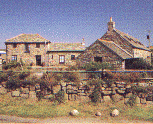|
The village of Zennor, on the Atlantic coast of Cornwall, lies only a few miles from the town of St Ives. It is bounded on one side by high, wild and rocky cliffs, and on the other by rugged, boulder-strewn, granite hills (Zennor Hill had a stone quarry, and much of St Ives was built with its stone, as was the Falmouth Harbour walls). Low farmhouses huddle close together in the brooding landscape of this wild and windswept coast; habitation here dates back to the early Bronze Age, 4000 years ago. The belt of land between was described in the last century as: Ref
The Church of St Senara In Cornwall, churches are usually small and ruggedly built to withstand the storms and gales which sweep across the county. There are very few spires, and their Celtic origins can be seen in their dedications, three-quarters of which are to Celtic saints. In the churchyards, there are numerous Celtic crosses. The church of St Senara in Zennor dates from Norman times, but probably stands on the site of a 6th century Celtic church. It is possibly named after the princess Azenor of Breton, the mother of St Budock. It was restored in 1890. Prior to the restoration , the whole edifice was in a very neglected state, with whitewash and green damp and rotteness everywhere. A rickety old kitchen table stood inside the altar rails, and the floor of the chancel was paved with common red bricks, and it "preserved for our instruction a sad picture of the surroundings amid which our great-grandfather's were content to worship. The original carved oak seats had all (with one exception) disappeared, and been replaced by family boxes".
The Parish Registers started about 1590, but the early portion was almost entirely destroyed by damp. The first volume is a small quarto bound in cloth. The first legible entry is "1618 Baptised Nicholas son of John Beryman" At the gate to the church, there is a "coffin rest". In the olden days, the dead might be carried in their coffins quite a distance from the church. Before carrying the coffin into the church, the coffin was placed on the coffin rest for a time and the pallbearers sat on the stone benches alongside, to assure it to be under good control when it was carried into the church for the burial service. The Berryman family Berymans, Berrymans and Berrimans have lived in and around Zennor since at least 1550, when William Beryman ("alias Porthmeo")farmed at Porthmeor, some 2 miles down the coast from Zennor. Berrymans have lived at that same farm since that time, and still live there today. Not many families can boast such a long, unbroken occupation of their family home! It is therefore not surprising that there are still quite a few Berrymans living in the area, with very many more buried in the Zennor churchyard.Another ancestral home of the Berrymans at Zennor was "Treveglos" ("Trev"--farmstead; and "eglos"--church: Thus, "farm of the church" or "church farm"). As a farm, "Treveglos" was known as early as 1270, but the present farm house was probably originally built in the late 1700s. The farm was once the property of a family named Treveglos; from 1384 to about 1661, it was the property of the Gerveys family, before passing to the Grylls. It is believed that Berryman families were the tenants from the 1600s to the mid-1800s. By 1872, however, it was owned by a Mr. Branwell of Penzance. In 1841, the population of Zennor Parish was just over 1,000 people. In 1851 it was 918. There were at that time nine Berryman families and two single Berrymans (one a charwoman and the other a servant). Most Berrymans of those times were farmers, but there was also an innkeeper. At the end of the 1800s, the population of Zennor Parish was 601, including several Berrymans, Chellews, Eddys, Hockings, Osbornes, Quicks, and Thomases, who were mostly farmers. Mrs. Hocking was a shopkeeper at Zennor Churchtown and Miss Elizabeth Berryman was the mistress of the National School (average attendance 80). John Trudgen end John Thomas were smiths. The chief landowners were the Earl of Sandwich; Caroline, Duchess of Cleveland; and Walter John Groves. Agricultural lands were devoted mostly to pasture and production of barley, oats, and wheat. Col. "Freddie" Hirst, archaeologist and founder of the Wayside Museum, Zennor, made the following observation in the 1930s:"In Zennor, the progenitor Adam has been replaced by Berryman, with the following result:-
It is only a matter of time for all Zennor people to be called Berryman - the Vicar (1925) called everyone Berryman until corrected, and thus learned the names of his parishoners". Local Facts
Henry Quick (1792-1857) of Zennor was a poet. A book has been written about him - "The Life and Progress of Henry Quick of Zennor" - P.A.S. Pool (Ed), 1994. D.H.and Frieda Lawrence rented Tregerthen cottage, near Zennor. The "Witches' Rock" at Trewa, between Nancledra and Zennor, was where the witches of Penwith are supposed to have "assembled at midnight to carry on their wicked deeds". However, anyone touching the rock nine times at midnight was insured against bad luck. Zennor Links The
Smugglers of Zennor 1. "The Parochial History of Cornwall" , founded on the manuscript histories of Mr Hals and Mr Tonkin (1838). 2. "A history of the parishes of Saint Ives, Lelant, Towednack and Zennor in the county of Cornwall", by John Hobson Matthews, 1892.
|











 The
last bastions of the Cornish language were the West Penwith parishes of Zennor,
St Ives, Lelant and Towednack. John Davey (1812-1891) of Boswednack,
Zennor (left) was one of the last people with a traditional knowledge of the
language.
The
last bastions of the Cornish language were the West Penwith parishes of Zennor,
St Ives, Lelant and Towednack. John Davey (1812-1891) of Boswednack,
Zennor (left) was one of the last people with a traditional knowledge of the
language.